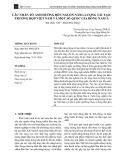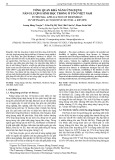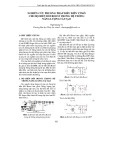
15
HUNG VUONG UNIVERSITY JOURNAL OF SCIENCE AND TECHNOLOGY Vol. 37, No. 4 (2024): 15 - 24
*Email: pkduy@bdu.edu.vn
TẠP CHÍ KHOA HỌC VÀ CÔNG NGHỆ
TRƯỜNG ĐẠI HỌC HÙNG VƯƠNG
Tập 37, Số 4 (2024): 15 - 24
HUNG VUONG UNIVERSITY
JOURNAL OF SCIENCE AND TECHNOLOGY
Vol. 37, No. 4 (2024): 15 - 24
Email: tapchikhoahoc@hvu.edu.vn Website: www.hvu.edu.vnjst.hvu.vn
STRATEGIC MANAGEMENT OF RENEWABLE ENERGY ENTERPRISES:
A PSM AND PLS-SEM APPROACH TO SUSTAINABLE BUSINESS MODELS
IN VIETNAM
Phan Khanh Duy1*
1 Faculty of Economics, Binh Duong University, Binh Duong
Received: 17 November 2024; Revised: 05 December 2024; Accepted: 07 December 2024
DOI: https://doi.org/10.59775/1859-3968.229
Abstract
The findings reveal that strategic management practices significantly improve both financial (β=0.35, p<0.01)
and environmental (β=0.42, p<0.01) performance. Innovation capabilities and operational efficiency were
confirmed as critical mediators, with innovation primarily influencing financial outcomes (β=0.15, p<0.05)
and operational efficiency driving environmental performance (β=0.18, p<0.05). The study provides actionable
recommendations for managers in renewable energy enterprises, emphasizing the need to foster innovation,
enhance operational efficiency, and develop sustainable business models. Strategies are vital for aligning
profitability with sustainability objectives in Vietnam’s rapidly expanding renewable energy sector.
Keywords: Strategic nanagement, innovation, renewable energy, sustainability.
1. Introduction
The global push for renewable energy is
a key strategy in combating environmental
degradation and achieving Sustainable
Development Goals (SDGs). As a signatory to
the Paris Agreement, Vietnam has positioned
itself as a regional leader in renewable
energy adoption, with ambitious plans to
increase renewable energy to 32% of its
total power capacity by 2030 [1]. Renewable
energy enterprises are pivotal in this
transition, driving innovation in solar, wind,
and biomass technologies while contributing
to economic growth [2]. However, these
enterprises face numerous challenges,
including financial constraints, regulatory
hurdles, and volatile market conditions.
Strategic management practices have been
identified as critical for overcoming these
barriers. By fostering innovation capabilities
and enhancing operational efficiency, these
practices improve enterprise resilience,
financial performance, and alignment
with sustainability goals [3]. Despite their
importance, the role of strategic management
in Vietnam’s renewable energy sector remains

16
HUNG VUONG UNIVERSITY JOURNAL OF SCIENCE AND TECHNOLOGY Phan Khanh Duy
underexplored, particularly regarding its
impact on financial and environmental
outcomes [4]. This study addresses this gap
by employing an innovative methodological
framework that combines Propensity
Score Matching (PSM) to ensure robust
causal inference and Partial Least Squares
Structural Equation Modeling (PLS-SEM)
to capture complex structural relationships.
It aims to evaluate the causal impacts of
strategic management practices, investigate
the mediating roles of innovation capabilities
and operational efficiency, and provide
actionable insights to foster sustainable
business models and green economic growth
in Vietnam’s renewable energy enterprises.
2. Literature review and Methods
2.1. Literature review
2.1.1. Strategic management in renewable
energy enterprises
Strategic management practices are
critical for enhancing innovation, operational
efficiency, and sustainability in renewable
energy enterprises. These practices facilitate
the adoption of advanced technologies,
improve resource utilization, and align
organizational goals with environmental
objectives. For instance, Lee and Tang (2022)
argue that strategic practices such as cross-
sectoral collaboration and R&D investments
directly impact the ability of firms to innovate
and achieve operational efficiency [5]. In a
global context, firms like Tesla and Ørsted
demonstrate how strategic management
drives not only market competitiveness but
also sustainability leadership through the
integration of innovation into core business
processes [3].
Vietnam’s renewable energy sector
presents a unique context for strategic
management. With rapid growth in solar
and wind energy projects, firms are under
increasing pressure to balance financial
performance with environmental goals [1].
However, many Vietnamese enterprises lack
the structured strategic frameworks seen in
more developed markets, which can limit
their ability to scale operations effectively.
The role of strategic management in fostering
operational efficiency and sustainability
in this rapidly growing sector thus merits
further exploration.
2.1.2. Sustainable business models
Sustainable business models in the
renewable energy sector emphasize the
integration of environmental, social, and
economic goals. A well-designed model
ensures that firms achieve profitability
while contributing to broader sustainability
objectives. Key characteristics include a
focus on renewable resource utilization,
long-term value creation, and stakeholder
engagement [6]. Balancing financial
performance with environmental outcomes
is particularly important in emerging
markets like Vietnam, where the renewable
energy sector is still maturing. Firms often
face trade-offs between cost-efficiency
and environmental responsibility. For
example, Tran and Vo (2019) highlight that
enterprises with strong commitments to
sustainability often experience short-term
financial challenges but achieve significant
long-term gains through enhanced brand
equity and regulatory support [4]. Such
models not only foster resilience but also
align with Vietnam’s green economic
strategy, making them an essential
component of strategic planning.

17
HUNG VUONG UNIVERSITY JOURNAL OF SCIENCE AND TECHNOLOGY Vol. 37, No. 4 (2024): 15 - 24
2.1.3. Methodological approaches
Propensity score matching (PSM)
PSM is widely recognized as a robust
technique for causal inference, particularly
in management studies where selection bias
is a concern. By creating matched samples
of treated and control groups based on
observable characteristics, PSM ensures that
comparisons between groups are unbiased
and reliable [7, 8] Recent applications of
PSM in renewable energy contexts include
studies on the impact of policy incentives
on firm performance, which demonstrate its
effectiveness in evaluating causality [1].
Partial least squares structural equation
modeling (PLS-SEM)
PLS-SEM is a versatile method for
analyzing complex relationships between
latent constructs, particularly when the
data is non-normal or the sample size is
small. It is widely used in studying multi-
dimensional constructs like performance
and sustainability [9]. In renewable energy
research, PLS-SEM has been employed
to evaluate how innovation mediates the
relationship between strategic practices and
performance outcomes [10]. Combining
PSM and PLS-SEM offers a powerful
framework for addressing both selection bias
and structural complexity. This integrated
approach is particularly suited to renewable
energy enterprise studies, where both causal
inference and an understanding of latent
constructs are essential.
2.1.4. Research gaps
Despite increasing global interest
in renewable energy enterprises, the
organizational and strategic dimensions
of enterprise management remain
underexplored, as much of the existing
research focuses on technological innovations
and policy frameworks. For example, Nguyen
et al. (2021) analyze the role of policy
incentives in renewable energy adoption but
neglect internal strategic practices that shape
enterprise performance, while Lee and Tang
(2022) highlight sustainability practices
without addressing the mediating roles of
innovation capabilities and operational
efficiency. Similarly, Tran and Vo (2019)
identify financial constraints as barriers but
fail to explore the strategic mechanisms that
help firms overcome them. In the context of
Vietnam, Pham et al. (2022) underscore the
importance of strategic management practices
but provide only descriptive insights without
robust analytical frameworks. Additionally,
Yun et al. (2020) demonstrate that strategic
innovation enhances both financial and
sustainability outcomes but focus primarily
on developed markets, leaving gaps in
understanding emerging economies like
Vietnam. To address these gaps, this study
employs a mixed-method quantitative
approach, integrating Propensity Score
Matching (PSM) for causal inference and
Partial Least Squares Structural Equation
Modeling (PLS-SEM) to analyze complex
structural relationships.
2.1.5. Research hypotheses
Based on the literature review, six
hypotheses are proposed to explore the
relationships between strategic management
practices, mediators, and performance
outcomes. Strategic management practices
are hypothesized to positively influence
financial performance (H1) as firms that
adopt resource optimization and invest in
innovation are better positioned to enhance
profitability [3]. Similarly, these practices are
expected to positively impact environmental
performance (H2) by aligning business
strategies with sustainability goals, enabling

18
HUNG VUONG UNIVERSITY JOURNAL OF SCIENCE AND TECHNOLOGY Phan Khanh Duy
firms to reduce emissions and improve
environmental outcomes [1]. Innovation
capabilities are proposed to mediate the
relationships between strategic management
practices and financial performance (H3) by
driving product and process improvements
that enhance profitability [9], as well
as environmental performance (H4) by
facilitating cleaner production processes
that reduce environmental impact [10].
Additionally, operational efficiency is
hypothesized to mediate the relationship
between strategic management practices
and financial performance (H5) through cost
reductions and improved resource utilization
[1]. and environmental performance (H6) by
minimizing waste and energy consumption
to support sustainability [5].
2.2. Research methodology
2.2.1. Research design
This study adopts a mixed-method
quantitative approach, integrating Propensity
Score Matching (PSM) and Partial Least
Squares Structural Equation Modeling (PLS-
SEM) to examine the causal relationships
and structural pathways in strategic
management practices among renewable
energy enterprises in Vietnam. The PSM
approach ensures robust causal inference by
mitigating selection bias between enterprises
adopting strategic practices and those that do
not. PLS-SEM enables an in-depth analysis
of complex relationships between strategic
management practices, mediators such as
innovation and operational efficiency, and
performance outcomes, including financial
and sustainability metrics (Hair et al., 2019).
Focusing on renewable energy enterprises
in Vietnam provides a unique context,
where rapid adoption of renewable energy
technologies coincides with the need for
effective strategic management to balance
financial performance and sustainability.
This design ensures methodological rigor
while generating actionable insights for both
academia and practice.
2.2.2. Data collection
The data collection process employed
a mixed-method quantitative approach,
integrating primary and secondary data
sources to ensure comprehensive and valid
insights. Primary data was gathered through
structured surveys targeting managers and
executives of renewable energy enterprises
in Vietnam, focusing on constructs such
as innovation capabilities, operational
efficiency, and sustainability outcomes. A
multi-channel distribution strategy, including
online surveys, email invitations, and in-
person interviews, was used to maximize
response rates and reduce non-response
bias. Secondary data was collected from
government reports, industry publications,
and enterprise disclosures, providing
standardized metrics on profitability,
emissions reduction, and resource efficiency.
To support causal analysis, a sampling
strategy divided enterprises into two groups:
those adopting strategic management
practices and those that did not. The initial
population of 400 enterprises across the
solar, wind, and biomass sectors was
reduced to 319 matched enterprises after
applying Propensity Score Matching (PSM)
to address selection bias. Logistic regression
calculated propensity scores based on
firm size, market conditions, and capital
investment, with nearest-neighbor matching
ensuring balanced characteristics between
groups. This approach enhanced the study’s
validity and robustness, confirming balance
through standardized mean differences and
propensity score diagnostics.

19
HUNG VUONG UNIVERSITY JOURNAL OF SCIENCE AND TECHNOLOGY Vol. 37, No. 4 (2024): 15 - 24
2.2.3. Propensity score matching (PSM)
PSM is employed to address selection bias
by creating comparable groups of treated
and control enterprises. This ensures that
differences in outcomes are attributable to
strategic management practices rather than
pre-existing disparities.
Objective: Mitigate selection bias and
ensure balanced covariates between groups.
+ Step 1: Estimate Propensity Scores:
Propensity scores are estimated using a
logistic regression model. Covariates include
Firm size, Market conditions (e.g., regional
energy demand, competition levels) and
Capital investment in renewable energy
projects.
+ Step 2: Apply Nearest Neighbor
Matching: Matched pairs of treated and
control enterprises are selected based on the
closest propensity scores, with a caliper set
at 0.1 to minimize bias.
+ Step 3: Conduct Balance Diagnostics:
Post-matching, balance diagnostics are
conducted to evaluate the similarity of
covariates between treated and control
groups using standardized mean differences
and propensity score distributions (Austin,
2011). Output: The matched dataset ensures
that the effect of strategic management
practices is isolated from confounding
variables, providing a reliable foundation for
subsequent PLS-SEM analysis.
2.2.4. Partial least squares structural
equation modeling (PLS-SEM)
Partial Least Squares Structural Equation
Modeling (PLS-SEM) was employed
in this study to rigorously analyze the
hypothesized relationships between
strategic management practices, mediators,
and performance outcomes. This method
is particularly effective for examining
complex, multi-dimensional constructs
in small to medium-sized datasets, as it
accommodates non-normal data distributions
and allows for simultaneous testing of
multiple interdependent relationships [9].
The primary objectives of using PLS-SEM
were to investigate the direct and indirect
effects of strategic management practices on
financial and sustainability outcomes and to
evaluate the mediating roles of innovation
capabilities and operational efficiency in
these relationships.
The analysis was conducted in
two interconnected components: the
measurement model and the structural
model. The measurement model validated
latent constructs such as strategic
management practices (e.g., innovation
strategy, efficiency optimization), financial
performance (e.g., profitability, revenue
growth), and sustainability outcomes (e.g.,
emissions reduction, resource efficiency).
Reliability and validity were rigorously
tested using Cronbach’s alpha and Composite
Reliability (CR), with values exceeding 0.7
confirming internal consistency, and Average
Variance Extracted (AVE), with values
above 0.5 confirming convergent validity.
The structural model tested hypothesized
paths, including direct relationships (e.g.,
strategic practices influencing financial
and sustainability outcomes) and indirect
relationships mediated by innovation
capabilities and operational efficiency.
Data analysis involved several critical
steps to ensure robustness. Reliability and
validity testing validated the measurement
model, while bootstrapping with 5,000
samples estimated the statistical significance
and confidence intervals of path coefficients.
Mediation analysis, using the Variance
Accounted For (VAF) approach, quantified



















![Ngân hàng trắc nghiệm Kỹ thuật lạnh ứng dụng: Đề cương [chuẩn nhất]](https://cdn.tailieu.vn/images/document/thumbnail/2025/20251007/kimphuong1001/135x160/25391759827353.jpg)






